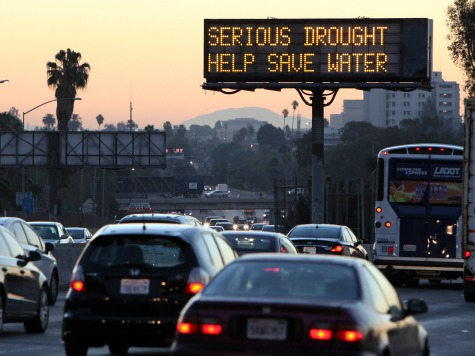California’s water problems continue to mount. On Tuesday, a report from the Water Resources Control Board showed that Californians are not cutting their water use to comply with statewide conservation efforts.
Governor Jerry Brown had requested a 20 percent decrease in statewide water use in his emergency drought declaration in January; according to the Sacramento Bee, state residents fell “well short” of that goal, cutting water use by just five percent between January and May of this year.
On Tuesday evening, a water main burst in Burbank, creating a 20-foot-long, 20-foot-deep sinkhole in the parking lot of the Burbank Fire Department’s training center. Area residents grabbed boogie boards and hung out, according to CBS Los Angeles, but still lamented the wasted water.
“We were all running around in the water,” area woman Alisabeth Boensel said in the report. “The kids had their boogie boards and they were surfing. It kind of sucks to lose all that water.”
While there are no easy answers on how to solve California’s worst drought in history, the state is building desalination plants up and down the coast, including the largest in the Western Hemisphere in San Diego County, in an effort to turn ocean water into drinking water. When that plant opens in 2016, it will provide 50 million gallons of drinkable water a day to the county.
Still, desalination plants are very expensive. California is spending $1 billion on the plant in San Diego County. Multiply that amount by the 10 to 15 planned facilities in the state, and desalination begins to look like an impractical option.
So, desperate for relief from the drought, California has invested $1 billion on statewide water recycling efforts, which means the state will essentially recycle waste water into drinking water. The method is actually much more cost-effective than desalination and can provide more water faster. However, according to the National Journal, people face a “psychological” challenge when drinking waste water.
“The problem with recycled water is purely psychological. Despite the fact that the water is safe and sterile, the ‘yuk factor’ is hard to get over, even if a person understands that the water poses no harm.”
Still, drinking recycled toilet water seems to be the best option for the state at this point. According to Slate, Orange County will tack on a $142 million extension to a water recycling plant that will bring in an additional 30 million gallons of drinkable recycled water when it opens in 2015. That means that Orange County “will soon produce twice as much water for less than one-third of the average cost of San Diego County’s desalination plant.”
Barring any kind of concerted, immediate water conservation effort by California’s residents, the state might want to listen to Slate’s advice: “If drinking purified pee weirds you out, don’t live in a desert.”

COMMENTS
Please let us know if you're having issues with commenting.